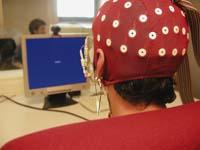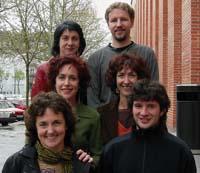2006/06/01
221. zenbakia

eu es fr en cat gl
Aparecerá un contenido traducido automáticamente. ¿Deseas continuar?
Un contenu traduit automatiquement apparaîtra. Voulez-vous continuer?
An automatically translated content item will be displayed. Do you want to continue?
Apareixerà un contingut traduït automàticament. Vols continuar?
Aparecerá un contido traducido automaticamente. ¿Desexas continuar?
Basque grammar in the brain
Text created by automatic translator Elia and has not been subsequently revised by translators.
Elia Elhuyar
The UPV Psychologistics Laboratory is investigating bilingualism in Basque and Spanish, analyzing the relationship between language and brain. And it is that the human brain is specially organized for us to appropriate the language. In addition, Catalan researchers and canaries collaborate with them in research on bilingualism. In this context, they analyze how the order of words, grammatical structures (case, concordance, etc.) are structured in the brain. of a language.
Basque grammar in the brain
01/06/2006 | Kortabitarte Egiguren, Irati | Elhuyar Zientzia Komunikazioa
The UPV/EHU researchers analyze how language is processed in adults, in this case the Basque language. In Basque you can use several word orders. Most linguists argue that the basic word order of the Basque language is SOV (subject, object and verb). For example, the woman has seen the man. Other word orders (man has been seen by the woman, the OSV order, for example) are derived from that basic SOV. These derived structures present a greater syntactic complexity than the basic ones and cause a greater processing of the brain.
Order of words

(Photo: A. A. Agirre)
To check the basic word order of the basque language, two types of experiments have been carried out. On the one hand, they have measured the times of reaction, that is, they have measured how long we need the Basques to read prayers of type SOV and OSV. Reading times show that in the case of SOV we need less time than in the case of OSV. Therefore, the SOV sentences with a basic word order of the Basque language are easier to process than the derived OSV prayers.
On the other hand, in the second type of experiment, electroencephalograms have been performed to several Basques. They have been placed a hood with several electrodes that measure brain activity. It indicates operations that have occurred in the brain immediately after applying a stimulus (100 milliseconds). Therefore, several Basques have had to put the electrode cap and read the prayers of the structure SOV and OSV before a screen. In this way, the behavior of the brain before each other is analyzed. They have seen it play differently. In the case of the Basque language, electrophysiological indications of the syntactic complexity of the displacement of the object in the OSV structure have been detected.
This research reinforces even more the main hypotheses that currently exist in the field of linguistics. In the light of research, the SOV structure is the order in which the Basque grammar creates by itself with the smallest number of works.
The Basques have also analyzed how we process ambiguous chains that can be SOV or OSV -- the woman has seen men, for example. The brain regularly sees these two structures, cannot process them simultaneously. Faced with ambiguous orders, the Basques choose SOV, and only if other factors force us to choose the OSV, for example, knowledge of the world forces us to eat sheep lobas in an order to choose OSV instead of the SOV order. Consequently, according to the results of the research team of the UPV/EHU, the Basque grammar has a basic word order, while the rest of the intensive syntactic operations carried out around it are syntactic operations of increase made around it.
Wrong Prayers Incorrect Prayers

The adult euskaldunes of birth and those who have learned Basque language in a different way process the violation of the subject.
UPV/EHU
In addition to analyzing the order of words, they have studied whether the organization of linguistic knowledge in the brain is the same or different way to organize in Basque from 3-4 years. They have used wrong sentences or grammatical errors as tools for it.
If we compare the correct and incorrect phrase processing, we would expect different results at the point where the error is found. In the research they used prayers that violate the structure of the phrase, verbal concordance, the case (ergative) and semantic. Compare incorrect and correct sentences in congenital and non-congenital speakers. The brain does not behave in the same way in both cases of bilingual Basque language. However, without analyzing the brain, it is not currently possible to separate both groups.
All this with adults in the Laboratory of Psicolinguistics. But it is usually said that the acquisition of language has a stage, a childhood. Children are the ones who most easily learn languages. In this sense, the UPV/EHU research team aims to start working in the future with young children.
Summary of the project
The aim of this work is to know how languages are organized in the brain of bilingual people. They have analyzed how the knowledge of Basque is organized in the brain, and if that knowledge is organized in the same or different way when Basque is the second language. This project integrates in its entirety a group of researchers from the Catalan universities UB and Canary ULL, as well as the research of bilingual Spanish-Catalan.
Director of the Director
Itziar Laka.
Working Team
X. Artiagoitia, A. Eguzkitza (ancient), A. Elordieta, K. Erdozia, M. Etxebarria, M. Ezeizabarrena, B. Fernández, S. Gomez and A. Zawiszewski.
Department of Commerce
Linguistics and Basque Studies.
Faculty of Faculty of Medicine
Faculty of Philology.
Financing Financing Finance
EUROCORES and Ministry of Science and Technology.
Page of the working group
http://www.ehu.es/HEB

From left to top, Beatriz Fernandez, Adam Zawiszewski, Itziar Laka, Arantzazu Elordieta, Mari Jose Ezeizabarrena and Kepa Erdozia.
(Photo: UPV)
Kortabitarte Egiguren, Irati
Services Services Services
221 221 221 221
2006 2006 2006 2006 2006
Security security security security
046 046 046
Universities; Biology; Humanities
Dissemination of knowledge
Library Library Library








